|
This revision is from 2009/04/17 11:21. You can Restore it.
Menu : Locustream
Menu : Locustreambox
Menu : Locustream SoundMap
Menu : Locustream interfaces & installations
LOCUSTREAM PROJECT - GUIDELINE FILE FOR STREAMERS
v.1.090417
1/ first step : register your stream on locusonus.org
Please follow the process below to configure your computer to
participate in the Locustream project and create an open mic.
- go to locusonus.org, click on Locustream SoundMap, on the soundmap, click on "admin" (alternatively, go directly to http://locusonus.org/soundmap/admin/ or choose "open a locustream webmic" from the RESS menu selection on locusonus.org)
- enter the default login/pass : prems/prems
- enter your desired login/pass and email address
- put requested information in the online form
- double check your information at the bottom of the page
- copy and paste the url of your stream created by the engine (its form will be : location_yourstreamname.ogg)
- save (on bottom-left of your browser window)
- log out (each registration is good for one stream. If you're managing several streams, each needs a unique login/pass)
- click on "go to the locustream soundmap" and check if all is ok
- you're automatically subscribed to the Locustream mailing-list for exchanging information with other streamers about your experience and ask for support if you've got problems. This will also serve as an announcement list for ongoing projects and Locustream events.
- next step : how to open a webmic and to send your stream to the Locustream server
- Note : your email address is required by the registration process. An invalid address will cancel your registration.
- Note : important - don't forget your login/pass, because you will need it to manage your stream and to modify information relating to it.
-

2/ configure a personal machine for Locustream or your locustreambox
You currently have the option of selecting a PureData patch (Windows, OSX, Linux) or a standalone OSX application for streaming.
- 2.1/ with PureData (osX, Win, Linux)
- if it's not already installed, download and install the last
version of Pd-extended (http://puredata.info/downloads) compiled by Hans-Christof Steiner
- to download the locustream pd patch, send a message to support (at) locusonus.org
- configure your microphone installation (see paragraph 4)
- open the Locustream Pd patch and check the sound input (audio input or external soundcard, in checking the Media/Audio Settings in Pd)
- go to step 2.3
-

- 2.2/ with Locus Streamer, stand-alone app (osX, Windows version forthcoming)
- 2.3/ start your stream
- on your screen, adjust your audio level and correct it in using the internal equalizer
- (reminder : if you're using a external soundcard, configure it in the PureData menu "Media/Audio Settings" or on the Locus Streamer by clicking on "open advanced audio properties")
- when all is ok, type your stream settings in the patch (stream-name by typing the exact characters previously given by your register on the online form, your-name and location)
- click on "stream" (ie the white big square in the Locus Streamer window)
- check in "pd oggcast" if the Pd oggcast 'state' is 1 and if the pages are sent (or if the button "streaming" turns in green on the Locus Streamer window)
- verify your stream url :
http://locus.creacast.com:9001/location_yourstreamname.ogg
- final step : go to the Icecast page of our streaming server, http://locus.creacast.com:9001/ . After copying the url of your stream (ctrl-click the loudspeaker icon), you can listen to your stream with VLC (http://www.videolan.org/) to adjust sound quality and the position of your microphone
- go to step 5
3/ stream with the LocuStreamBox
We have developed a "streambox" - a mini-PC equipped with a microphone and configured to connect to our streaming server as soon as it is plugged in. These boxes are equipped with a wireless connection, they use very little electricity, and run silently (it doesn't need a fan to cool itself). It has a sound card, video out, 2USB and a network card. So yes, its like plug and play for the streams. Streamers may request a Streambox for a nominal fee, in order to ensure the permanent functioning of the webmics. We are currently (Spring '09) beta testing the streambox, the first version is now available : first prototype (v.1.0, 3C3, 0.5). And we're currently working on the v.1.1 (3D3). See below how to receive a LocuStreamBox.
Note : video documentation on the streambox's use : http://www.vimeo.com/1650869 and http://www.vimeo.com/2236743 (for
creating a ad-hoc network)
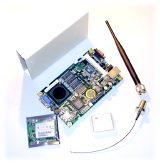
- 3.1/ installation (with a ethernet cable)
- plug in the ethernet cable (DSL), be sure there's a connection to the Internet via your router
- plug in a screen display (VGA plug)
- plug in a USB keyboard and mouse
- plug in the power cable (12-20V - centered + pole )
- check on the screen that is Linux booting. There will be a DHCP request for an IP. The process will not take longer than 3 min. The Pd patch for streaming will automatically open. (If the process is hangs, cycle power by unplugging the power, the powering it on again.)
- Once PureData opens the streaming patch, configure your microphone installation and plug in your microphone in the streambox audio input (see paragraph 4)
- adjust your audio level in the patch (the normal level is 1, up to 4) and correct it in using the internal equalizer if it's needed
- when all is ok, select your keymap and type your stream settings in the patch (stream-name by typing the exact characters previously given by your register on the online form, your-name and location)
- save the patch with ctrl+s or via the File menu
- Turn OFF the streambox using the little icon on the bottom right or via the system menu (you also see the reboot. halt, logout options via right click). Everything should have saved. The application will reopen with your recorded settings and configuration
- Be careful : to plug out the power of the streambox and plug in again might affect seriously the LocuStreamBox system. This is not recommanded
- check in "pd oggcast" if the Pd oggcast 'state' is 1 and if the pages are sent
- verify the url of your stream :
http://locus.creacast.com:9001/location_yourstreamname.ogg
- final step : on your personal machine, go to the Icecast page of our streaming server, http://locus.creacast.com:9001/ . After copying the url of your stream (ctrl-click the loudspeaker icon), you can listen to your stream with VLC (http://www.videolan.org/) to adjust sound quality and the position of your microphone
- If desired, you can unplug the keyboard, mouse and monitor (or simply turn it off)
-
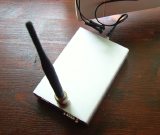 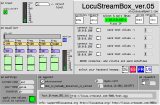  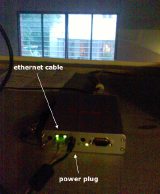
- 3.2/ installation (with WiFi - still in progress)
Same steps than above, except :
- The Streambox will request for an IP both on the wired and the wireless card (if theres one present) keep in mind that the AP (Access Point) should be open. In case the wireless network is encrypted a more complex routine will be required. The Streambox is capable to stream over encrypted networks, if you will like to stream using this type of network please contact us so to help you configuring the device accordingly.
- 3.3/ Troubleshooting/ Known Issues
- On streambox v1.0 (3C3) (1 Feb - 20 Apr 2009) : if you remove the screen, place a jumper that connects pins 5 & 12 on the monitor out connector (we can send you a howto picture or see pictures above). (if you reconnect the monitor, don't forget to replace the jumper after your operation)
- before plugging in the streambox, check the power supply plug-in : 12 - 20 V (18 V is recommended), with the + pole in the center
- if there is a problem with the server, or you have connection problems, the Streambox will reboot automatically.
- Note : the buffer delay time needs to be increased (in audio settings) from 50 msecs to 200 msecs, it seems to illiminate some saturation.
- Note : we tested the use of a standard USB soundcard (EDIROL UA-1) on the LocuStreambox. The recognition by Linux is automatic. This requires to change audio settings in Pd (Media/Audio Settings menu) by replace the default input/output device by OSS device#2 (instead of #1). We recommend to not click on "Save all settings" because it's a cause of a harsh error when the streambox is rebooted without the audio soundcard. Using an external USB soundcard requires to manually change these settings each time the streambox is rebooting. So this use is not recommended.
- Note : some ground noise problems on the LocuStreamBox when the monitor is unplugged
- Note : to download the last version of Linux StreamBox system on your FlashCard : this process is in progress
4/ about microphones
- you can use your own (electret) microphone or your own sound configuration with a small mixtable and one mic (or more). Different types of mic can be used : electret, piezo, etc. It depends on the sound capture process and system you want to set up. It's possible to use a (standard) external USB soundcard directly plugged in the streambox (tests are successful with Hercules and Edirol UA-1EX products, but see Troubleshootings, paragraph 3).
In order to improve or to customize your sound captation, you can use acoustic filters and focusers, such as a parabola, a windshield, a windscreen, etc. Have a look at the webmics examples.
- we're currently building a LocusMic. It's a very small electret microphone with all the components into the sleeve of the jack. The microphone is a slightly higher quality omni electret made by Panasonic (MCE-4000). You can use a series of audio extension cable (jack 3.5mm). The electret is powered by the streambox (circa 5V). The LocusMic will be sent with LocuStreamBox bundle.
-
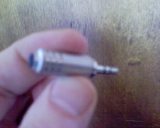
5/ listen to the Locustream SoundMap
We have created a animated map which shows the location of all the streams worldwide. Those currently active have a blinking light. By clicking on a location, one can listen to the audio stream in a browser.
- go to locusonus.org
- click on Locustream SoundMap (or directly go to http://locusonus.org/soundmap/)
- check if your stream is well on
- clicking on a stream name will open a pop-up window to listen
- wait a few moment, and accept the Java ogg player certificate
- open your ears and don't forget go to listen to the other streams
6/ other listening interfaces
- the Locustream webmics are played by interfaces and systems other than the SoundMap : online apps or sound installations (such as Locustream Tuner, Locustream Promenade, Locustream Audio Tardis)
- we wish you stream as long as you can, continuously, to be played by the various interfaces (this is the impetus of the development of the LocuStreamBox)
- Sound installations (Tuner, Promenade) are publicly and temporarily shown. You will be informed via the mailing-list about events and dates
- The Audio Tardis is continuously available online (on the front page of locusonus.org or directly at http://locusonus.org/tardis/). It is a listening sequencer and soundscape-saver, automatically navigating amongst the live webmics.
- Soon available on the soundmap : the ability to mix multiple streams on a playable interface (still in progress)
- The Locustream project generates continuous studies and listening experiments (like the Carpophores project by Esther Salmona and Journal de Bord by Nicolas Bralet - see on our website for more info -, and other studies by researchers in sociology and architecture). We are glad if you would send us feedback about your own experience and reflections.
- The Locustream project is an open-sourced project and provides a sound ressource that feeds sound and music projects. You are welcome to develop your own projects using the locustream open mics (to see other projects that involved the webmics, go to locusonus.org, menu / PROD / external projects)
7/ how to receive a LocuStreamBox
We currently finalize a prototype v.1.0 with firmware v.0.5. It's still in development but the prototype is working well. In order to receive a streambox, please contact support (at) locusonus.org . The cost is being finalized, but will be around 160/170 euros (plus shipping).

8/ aknowledgements and contacts
- The LocuStreamBox is developed by Alejo Duque (Locus Sonus), The Locus Streamer stand-alone by Scott Fitzgerald (Locus Sonus), The LocusMic by Peter Sinclair (Locus Sonus), Locustream SoundMap and Tardis by Jérôme Joy (Locus Sonus)
- Thanks to Hans-Christof Steiner for Pd-extended maintenance, to Olaf Matthes for Pd & Max/MSP ~ogg objects, to GOTO10 for Pure:Dyne distrib and to the very helpful supports provided by the users & developers communities. Thanks to Stéphane Cousot for PHP/mySQL programmings and Gilles Misslin (Creacast) for streaming server maintenance and bandwith.
- Contact : support (at) locusonus.org
Post-grad research group : École Supérieure d'Art d'Aix-en-Provence (School of Arts), École Nationale Supérieure d'Art de Nice Villa Arson (School of Arts), in association with CNRS/MMSH/LAMES Lab Univ. de Provence (Samuel Bordreuil, Sociology Research Lab).
Research Directors : Jérôme Joy, Peter Sinclair.
Administrative coordination : Anne Roquigny.
2007/2009 Locus Sonus Lab: Julien Clauss, Alejo Duque, Scott Fitzgerald, Jérôme Joy, Peter Sinclair.
2005/2007 Locus Sonus Lab: Nicolas Bralet, Sabrina Issa, Jérôme Joy, Nicolas Maigret, Esther Salmona, Peter Sinclair, Lydwine Van der Hulst.
Fellows: Brett Ian Balogh (SAIC), Stéphane Cousot (Ind.), Clémentine Maillol (CNRS), Jean-Louis Paquelin (ENSA Nice Villa Arson).
Scientific Council 2006/2007 : Samuel Bordreuil, Philippe Franck, Bastien Gallet, Christophe Kihm, Bernard Stiegler, Raphael De Vivo, Michel Waiswisz.
Webmaster : Locus Sonus lab.
|

